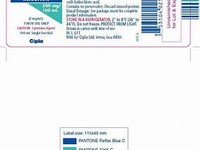Epirubicin hydrochloride
CLINICAL USE
Antineoplastic agent:Leukaemias Malignant lymphomas Multiple myeloma Various solid tumours
DOSE IN NORMAL RENAL FUNCTION
60–90 mg/m2 every 3 weeksHigh dose: 100–135 mg/m2 every 3–4 weeks,or 45 mg/m2 on days 1, 2, and 3, every 3 weeksOr according to local protocol
PHARMACOKINETICS
DOSE IN RENAL IMPAIRMENT
GFR (mL/MIN)
DOSE IN PATIENTS UNDERGOING RENAL REPLACEMENT THERAPIES
IMPORTANT DRUG INTERACTIONS
Potentially hazardous interactions with other drugs
ADMINISTRATION
Reconstition
Reconstitute with water for injection or sodium chloride 0.9% (rapid dissolution only)
Route
IV, intravesical (bladder instillation), intrathecal
Rate of Administration
IV: give via the tubing of a fast running intravenous infusion of sodium chloride 0.9% or glucose 5%, taking 3–5 minutes over the injection
IV infusion
: 30 minutes
Comments
For bladder instillation: concentration of epirubicin in bladder should be 50–80 mg per 50 mL once a week. To avoid undue dilution in urine, the patient should be instructed not to drink any fluid in the 12 hours prior to instillationIn the case of local toxicity dose is reduced to 30 mg per 50 mL
OTHER INFORMATION
A cumulative dose of 900–1000 mg/m 2 should only be exceeded with extreme caution. Above this level, the risk of irreversible congestive cardiac failure increases greatlyMainly metabolised in the liver; 27–40% eliminated by biliary excretion. Slow elimination through the liver is due to extensive tissue distribution. Urinary excretion accounts for approximately 10% of the dose in 48 hrsPatients with impaired hepatic function have prolonged and elevated plasma concentrations of epirubicin – dose reduction is requiredEpirubicin may make the urine red for 1–2 days after administration
